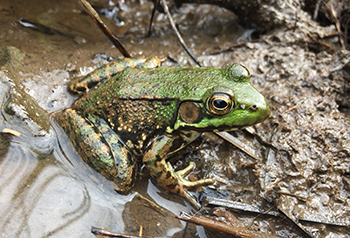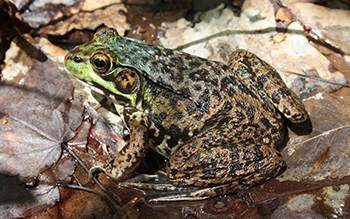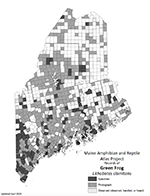Home → Fish & Wildlife → Wildlife → Species Information → Reptiles & Amphibians → Green Frog
Green Frog
Lithobates clamitans
On this page:

Photo: Trevor Persons
Distinguishing Characteristics

Photo: Trevor Persons
- Medium-sized, approximately 2 to 4 inches in length
- Green or greenish-brown above, underside whiteish, throat often yellow
- Dusky bars across hind legs
- Prominent ridge (dorsolateral fold) extends along sides of back from behind eye to near groin
- Commonly confused with American bullfrog and mink frog
- Breeding call sounds like a banjo string being plucked
Status and Distribution in Maine
- Common and secure
- Statewide
Habitat
- Relatively aquatic, rarely found far from water
- Uses all types of temporary and permanent aquatic habitats from large streams, rivers, and lakes to small marshes, vernal pools, and roadside ditches and puddles
Diet
- Aggressive predator, eats anything it can catch including invertebrates, fish, snakes, or frogs (including other bullfrogs)
Seasonal Changes
- Overwinters underwater or underground
- Tadpoles overwinter in permanent aquatic environments
Natural History Notes
- Largely resistant to predation by fish because eggs and tadpoles toxic and unpalatable
Share Your Sighting
There is much still to learn about the distribution and ecology of Maine’s herpetofauna, and we encourage members of the public to share their photo-documented observations as part of the Maine Amphibian & Reptile Atlas Project (MARAP).
To see if a township still needs documentation of a species, consult this distribution map (PDF). If a township lacks a photo or specimen record, we want your observation!
There are two ways to share your observations:
Submit your reptile or amphibian observation online
No service? No problem. Click here to download the survey to your device while connected, then take offline to collect observations from anywhere. Tip: The survey works best on Google Chrome and Safari.
Or upload sightings to the iNaturalist citizen science project through their website at iNaturalist.org or mobile app.
- When submitting an observation through iNaturalist add a description of the location (and other noteworthy information) to the “notes” field. This serves as a check on the locations automatically generated by smartphone cameras, which may be imprecise if cell service or GPS coverage is weak.
Thank you for doing your part to help conserve Maine’s reptiles and amphibians.
